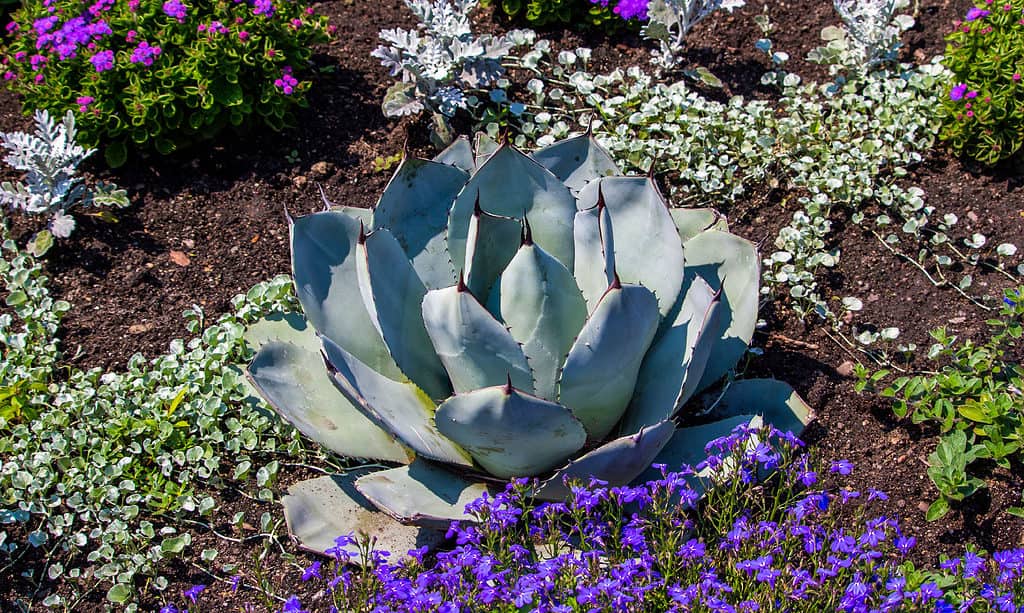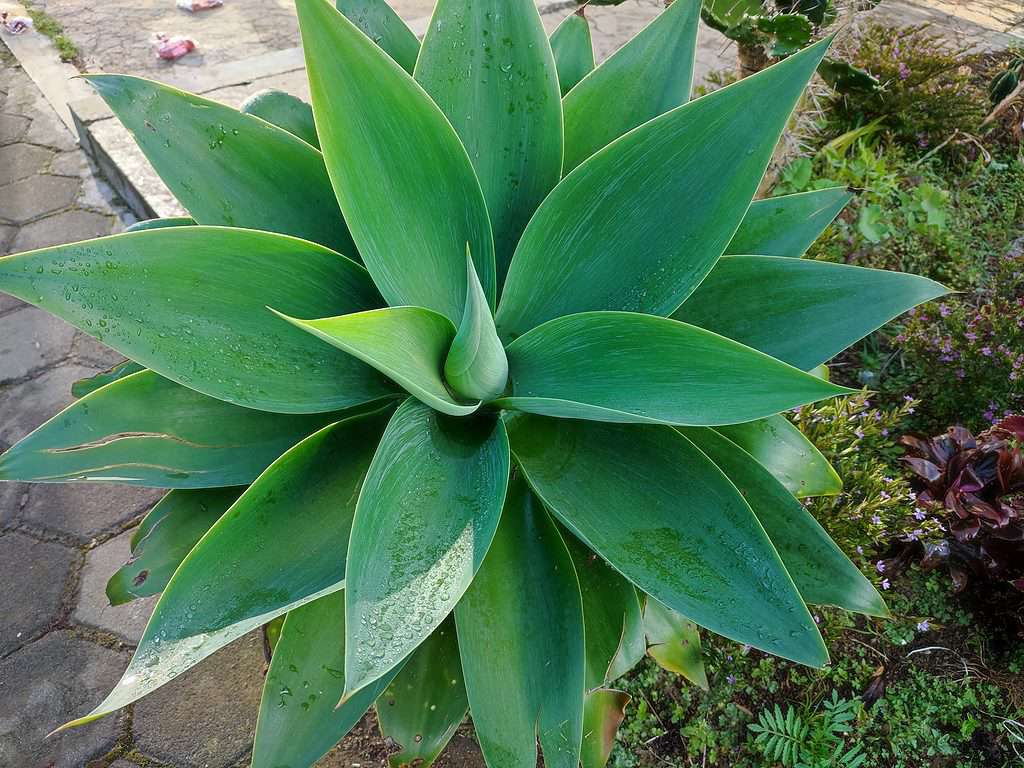Agave plants are a popular succulent known for their natural sweetness. While agave is often used in syrups and Southern cuisine, it’s best known for being a staple ingredient in tequila.
Whether you’re looking for an eye-catching addition to your garden or have your eye on hyper-local mixology, agave is a great succulent to add to your collection. However, nurturing this unique plant may be more than you bargained for.
In this article, we’ll cover what the agave plant is, how to grow it, and what to expect when harvesting agave for culinary purposes.
Let’s dig in!
What is the Agave Plant?

Agave plants are best known worldwide for their contributions to tequila production.
©iStock.com/camaralenta
The agave plant is a type of flowering succulent native to Mexico, Central America, and parts of South America. Like most succulents, the agave plant thrives in desert ecosystems and struggles in humidity.
Agave is a genus with several species, some better known than others. A few popular types of agave plants include:
- Blue Agave (Agave tequilana) – One of the most famous agave species, Blue Agave is primarily cultivated in Mexico for the production of tequila. It has striking blue-gray leaves and is known for its large size.
- Century Plant (Agave americana) – Also known as the American Agave or Maguey, this species is recognized for its dramatic and imposing appearance. It has broad, fleshy, and spiky leaves that can grow up to several feet long.
- Sisal Agave (Agave sisalana) – This tough agave is primarily cultivated for its strong fibers, which are used to produce sisal rope and other products. It has long, sword-like leaves and can grow to significant sizes.
- Narrow-leaved Agave (Agave angustifolia) – Unlike other agave plants, this agave is native to the humid, tropical regions of the Americas and has long, narrow leaves that form an attractive rosette.
- Fox Tail Agave (Agave attenuata) – Unlike many other agave species, this agave plant lacks sharp spines on its leaves. It has smooth, fleshy, and arching leaves that give it a unique appearance.
While the appearance and coloration may vary, most agave plants have spiny, pointed leaves reminiscent of an aloe plant.
Some species, like Agave parviflora, are small and compact, reaching no more than six inches tall. Others, like Agave salmiana grow well over 10 feet tall in ideal conditions.
Importance and Significance of Agave Plants
Agave plants are ingrained in Mexican and Central American cultures. This desert plant has been a naturally-occurring food source for indigenous tribes for centuries and was used similarly to aloe vera for traditional medicine. Agave use dates back to the Mayan and Aztec civilizations.
Agave is known worldwide as a key ingredient in tequila and mezcal. The difference between these plant-based liquors is which type of agave is used.
Tequila is a type of mezcal made exclusively with Blue Agave, whereas mezcal, in general, is made from several other types. A similar comparison would be champagne—it’s only champagne if it comes from the Champagne region in France; otherwise, it’s sparkling wine.
Agave fibers have been used to create textiles and crafts for centuries. The strong fibers of the Sisal Agave are used to produce ropes, baskets, mats, and paper crafts.
Agave, textile, and tequila production also have significant agricultural and economic impacts on Mexico and its people. The agave plant is considered a symbol of national pride and cultural heritage.
How to Grow Agave Plants from Seed

Artichoke agave is commonly used for landscaping in desert areas characterized by heat and reduced humidity levels.
©iStock.com/Cynthia Shirk
Agave can be grown outdoors in USDA zones 9-11. This heat-loving succulent won’t survive the frosts and harsh winters of Northern USDA zones. Fortunately, agave plants perform well in indoor pots.
Here’s a complete guide for growing agave plants from seed:
1. Seed Selection
Choose high-quality agave seeds from a reputable supplier or collect them from a mature agave plant in your area. Ensure that the seeds are fresh and viable for the best germination results.
2. Soil Preparation
Select a well-draining soil mix suitable for cacti and succulents. You can also create a custom blend by combining regular potting soil with coarse sand or perlite. Fill a shallow container or seed tray with the prepared soil.
Outdoors, ensure the soil is well draining, and the plot is in a place that receives full sun exposure. East or South-facing gardens are ideal for agave plants.
3. Planting Method
Sprinkle the agave seeds evenly over the surface of the soil in the container. Avoid overcrowding the seeds to provide each seedling with enough space to grow. Gently press the seeds into the soil without burying them too deeply.
Once the agave plants sprout, you may need to transplant them to allow for more space between rosettes.
4. Watering
Use a misting spray or a fine watering can to dampen the soil thoroughly without causing waterlogging. Agave seeds require consistent moisture for germination. Cover the container with a clear plastic lid or wrap it with cling film to create a mini-greenhouse effect that retains moisture.
Once the agave plants sprout, they’ll become sensitive to moisture. Switch to infrequent watering to prevent root rot, allowing the soil to dry completely before giving them a good soak. It’s better to underwater your agave than to overwater it.
5. Care and Maintenance
Agave is relatively low-maintenance and easy to care for. Water infrequently and remove dying or dropped foliage to prevent bacteria growth.
Agave plants should not be fertilized, as fertilization can promote premature blooming. Instead, repot your indoor agave every year to refresh the soil’s nutrients. Most agave plants only bloom once and die shortly after. When blooming and pollination occur, they drop seeds to produce new agave plants; this process shouldn’t happen for 7-10 years.
Monitor your agave plants for common pests, including:
- Agave snout weevil
- Aphids
- Mealybugs
- Scale bugs
- Spider mites
- Ants
Consider introducing natural predators, like ladybugs, to offset these pests without using chemicals.
How to Propagate Agave

Foxtail agave stands out with its flat, wide, smooth leaves which are much different from agave’s typical spiny foliage.
©Panji.Art/Shutterstock.com
You can propagate agave plants by transplanting pups from the parent plant. The best time to propagate agave through division is during the spring or early summer when the plant is actively growing. Prepare the parent plant by watering it a few days before you plant to propagate.
Gently remove pups from the parent plant and place them somewhere safe, out of direct sunlight for a few days. Then, transplant them to a new pot. Depending on the type of agave plant, you may need to excise the pups with a sharp, clean knife.
Water gently until the roots are established, using a mister if necessary. Keep the propagates out of direct sunlight for 2-3 weeks.
While it’s possible to propagate from cuttings or bulbils, this method is difficult and unreliable; propagating from pups is the most viable approach.
How Fast Does the Agave Plant Grow?
Agave plants are slow growers, taking years or even decades to mature. This slow growth and significant demand make conservation and sustainable harvesting paramount to protect these plants.
It’s important to understand that planting an agave plant to make your own tequila or mezcal could take 7-10 years. When your first-generation agave blooms, it will produce pups. Nurturing these pups will likely generate more nectar than relying on one parent plant.
As the agave plant matures, it develops sugar in its core—known as the “piña” due to its resemblance to a pineapple. When the piña is fully grown, it can range between 80-200 lbs! It must be carefully excised from the plant, then heated and expressed to remove the juice.
If you plant an agave plant today, you may be ready to make a small batch of tequila in 15-20 years.
The photo featured at the top of this post is © Dee Carpenter Originals/Shutterstock.com
Thank you for reading! Have some feedback for us? Contact the AZ Animals editorial team.






